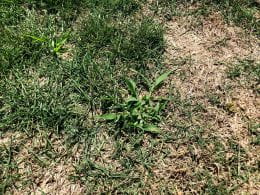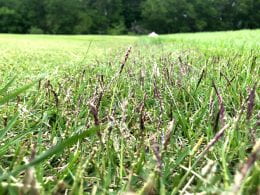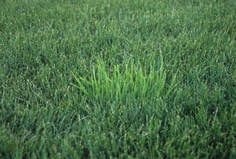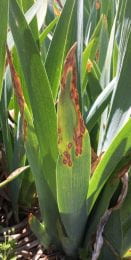By Dr. Cheryl Boyer
There are a lot of choices in the potting media aisle of your local garden center. If you don’t know what you’re looking for, it can be a confusing experience to read the label. Fortunately, there are three easy steps/considerations for screening the available choices down to one that works for your needs.
Step 1: What are you using it for?
It does make a difference whether you are planning to use media in a container or as a soil amendment in a raised vegetable bed or landscaping bed. Some materials are designed to hold water well while others are designed to drain well. What do you need for each of those situations?
- Growing plants in containers: Generally, you want to use a peat-based soil-less substrate for this application. Do not use field soil. These products are engineered for success in season-long growth of annual plants in containers of reasonable size for consumer use (very large containers are a different discussion). Peat-based mixes almost always have a “starter charge” of fertilizer mixed in to get your plants growing, but you’ll need to supplement with fertilizer as the season progresses. Old potting media has likely lost its starter charge and may, in fact, become hydrophobic (repels water) over time. You’ll need to spend some time rewetting and mixing old potting media for a new season if you intend to re-use it.
- Amending a landscape bed or raised bed: Products containing peat should not be the primary component but are acceptable in small quantities. Field soil mixed with compost and perhaps a coarse pine bark-size material is best in this situation. The objective is to enrich your existing soil with natural material that will break down over time and in the meantime provide nutrients and aeration for roots to grow well. Make sure to apply the material and mix/till it into a broad area and not just a single planting hole or your new plants may experience the “soup bowl effect” and succumb to rapid decline. Check with your local landscape contractor to get a large volume of soil delivered, perhaps even mixed with compost from a local municipal composting facility.
Step 2: Understanding Major, Minor, and Specialty Components
These materials are regionally sourced and often composted to reduce particle size. Some materials are manufactured for the purpose of being used in potting media and many more are by-products of other industries. They are all fine as components but look at the label to understand how much of each “ingredient” is mixed, by volume, into the product you’re purchasing. If that information isn’t on the bag, be wary of purchasing.
- Major components: Bark (or “composted forest products”), peat (this might be defined by type of peat which often refers to the source material or the coarseness), soil (don’t pay for this unless it’s local/regional and advertised as a single-component soil amendment—not as a potting media), manure, sand. Other waste-product alternative materials such as coconut coir and wood fiber are also great to use, but they’re not seen as often in consumer-level products.
- Minor components: Perlite (little white pellets–it’s for aeration, not fertilization), vermiculite (shiny heat-expanded rock pieces), rice hulls (also for aeration with an added bonus of weed control when applied to the tops of containers). These are the most common.
- Specialty components: mycorrhizae (symbiotic fungal organism that, mixed in, can be very beneficial in a container system by expanding the root capacity to take up nutrients and water, it’s less effective in field soil where these organisms are already abundant), fungicide (some products are designed to address specific fungal growth issues).
A note about manure and compost: These are good organic materials; however, you must be careful that the source can guarantee the material that produced the manure (hay, pasture grass, etc.) was not treated with herbicide. Many herbicides used in pasture management have a very long half-life and can persist in your landscape beds, killing desired plants.
A note about organic products: While most media components are considered “natural” and are likely produced using organic practices, few will be labeled as organic simply due to the nature of the organic certification process. An organically labeled product is not inherently better than another, though if you’re looking for a bagged manure product, organic will ensure the absence of herbicide residue.
Step 3: Mixing and Managing
Knowing what you’re working with and what you’re trying to do with it will help you understand how to manage it in practical use. These materials may also listed on the ingredient list and it’s helpful to know what to expect.
- Lime: One special challenge we have in Kansas is that we have a lot of limestone around, which raises the pH of our soil and our water. You may notice that many bagged products include lime or limestone as a fertilization amendment. This is because most soil-less media components are very low in pH, or acidic, and they’re trying to get the mix to be pH neutral (so that most nutrients are available for plant uptake). In Kansas, most of our soils are on the high pH, or alkaline, side. It is to our advantage to apply soil-less products that are low in pH because that will help to neutralize our native soil. We don’t need the added limestone, but it’s unlikely you’ll find a product that doesn’t have it mixed in. For sure, don’t add more!
- Fertilizer: As mentioned earlier, most bagged products have a “starter charge” of fertilizer. You won’t need to add anything immediately, but within a few weeks you’ll need to apply a water-based fertilizer (immediately available to plants) and/or a long-term slow-release fertilizer product. These usually come rated for months of use. A short-term product (3-4 months) may sound like it will last all summer, but if it gets really hot outside the pellets may release early (if temperature is the mode of operation). Combining a shorter-term product with a longer term one (8-9 months) may cover your needs for a longer time.
- Wetting agent: Some products, like peat, are harvested and packaged in a very dry state and may need help retaining water when ready for use. This will likely be pre-mixed, though if you can tell it’s very dry you may want to spread it in a wheelbarrow and mix in some water (and maybe your own re-wetting agent) until it’s consistent.
- Watering: Containers will need to be monitored for water more frequently than landscape beds, but they all need to be checked. This will vary in every situation, so you’ll need to keep an eye on it until you understand how all of the components are functioning together.
Potting media products are remarkably similar once you get past the packaging. Read the ingredient label (just like in the grocery store), find what you need for your application, and then choose the product that best meets your needs and your budget. Choose on price only after you’ve leveled the playing field of similar products.
Got questions about an unusual component? Let me know—I love a good alternative material discussion. Here is my email: crboyer@ksu.edu



 Orchardgrass often infests tall fescue lawns. Unfortunately, orchardgrass is lighter green and faster growing than tall fescue, so it is very visible. Homeowners complain of the light green tufts of grass wherever this weed has become established. To read more about this week, visit the
Orchardgrass often infests tall fescue lawns. Unfortunately, orchardgrass is lighter green and faster growing than tall fescue, so it is very visible. Homeowners complain of the light green tufts of grass wherever this weed has become established. To read more about this week, visit the  Iris leaf spot is not an easy disease to clean up because it overwinters in the residue. So the first step for management is to clean up the flower bed in the fall after frost has killed the tops. This will help to reduce the amount of disease that is carried over. Unfortunately it won’t get rid of the disease. If the planting is old and crowded, digging them up and respacing them will improve air flow. This can help to reduce disease severity.
Iris leaf spot is not an easy disease to clean up because it overwinters in the residue. So the first step for management is to clean up the flower bed in the fall after frost has killed the tops. This will help to reduce the amount of disease that is carried over. Unfortunately it won’t get rid of the disease. If the planting is old and crowded, digging them up and respacing them will improve air flow. This can help to reduce disease severity.
